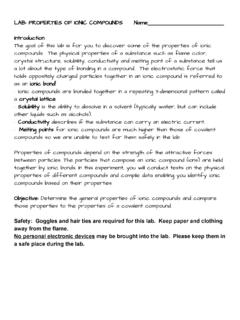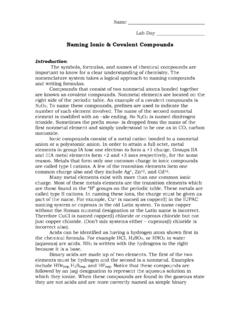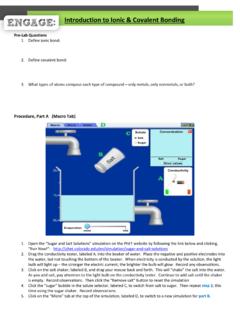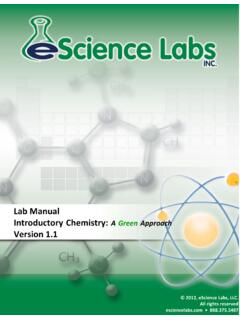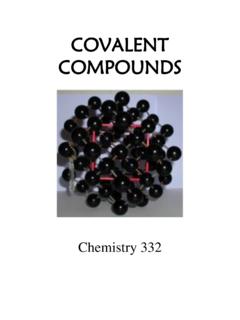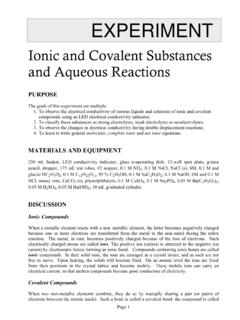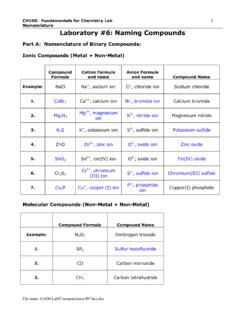Transcription of Lab Ionic and Covalent - Wag & Paws
1 13 Lab 12: Ionic and Covalent Bonds Objectives x Understand the differences between Ionic and Covalent bonding x Link Ionic and Covalent bonding with the physical properties of matter Introduction Have you ever accidentally used salt instead of sugar? Drinking tea that has been sweetened with salt or eating vegeta bles that have been salted with sugar tastes awful! Salt and sugar may look the same, but they obviously taste very different. They are also very different chemically. Salt is made up of sodium and chloride and is ionically bonded. Sugar, on the other hand, is com posed of carbon, oxygen, and hydrogen and has Covalent bonds. A salt (sodium chloride) molecule is made up of one sodium atom and one chlorine atom. In order for the atoms to combine, the sodium atom must lose an electron, while the chlorine atom must gain an electron; the resulting ions have opposite charges and at tract one another.
2 When sodium loses an electron it becomes a positively charged ion (Na+), called a cation. Na o Na+ + e- The chlorine atom adds this free electron, becoming a negatively charged anion. Cl + e- o Cl- A bond can now form between the negatively charged Cl and the positively charged Na+. This type of bond is called an Ionic bond. Ionic bonds typically form between one metal and one non metal ion. The above reaction can be written as: Na+ + Cl- o Na+Cl- Table sugar (sucrose) differs from salt in the bonding between its atoms. The atoms in sugar do not form ions; instead, they are held together because of shared electrons. This is an example of Covalent bonding. Table sugar has a much more complex chemical structure than salt (see Figure 3). A Covalent bond between one carbon atom and one hydrogen atom forms when one of the valence electrons of the carbon atom groups with one of the valence electrons of the hydrogen atom, forming an electron pair.
3 Figure 1: In order to undergo Ionic bonding, an electron must transfer between the Na and Cl atoms. This gives each atom an opposite charge, resulting in attraction. Figure 2: Covalent bonding diagram for meth ane (CH4). Note that both the carbon and hydrogen atoms have full outer shells. 14 Note: This is normally written C H. Ionically bonded compounds behave very differently from covalently bonded compounds. In the first part of this lab you will investigate how ionically bonded and covalently bonded substances behave differently in their conduction of electricity. You will do this by using a simple anodizing apparatus that uses a stainless steel screw and an iron nail as electrodes. In an anodiz ing apparatus the water between the electrodes must contain enough ions to conduct electricity. As this happens, the water will react to form hydrogen and oxygen gases.
4 2H2O o 2H2 + O2 In the second part of this lab you will explore the differences in melting points between ionically bonded and covalently bonded compounds. Figure 3: Chemical structure for table sugar (sucrose). Here, different atoms combine via Covalent bonding, as opposed to Ionic bonding. Notice the complexity of this molecule compared to NaCl. Lab 12: Ionic and Covalent Bonds 15 Pre lab Questions 1. What is an Ionic bond? 2. What is a Covalent bond? 3. Do you think sugar or salt will melt at a higher temperature? Explain your answer. Lab 12: Ionic and Covalent Bonds 16 Experiment: Sugar or Salt? Stainless steel is not very reactive, while iron will react with oxygen to form iron oxide, commonly called rust. You will use this fact to help determine how well dissolved sugar and salt conduct electricity. The melting points of sugar and salt can be tested by placing a small amount of substance in a test tube and heating it at differ ent heights over a burner or lighter flame.
5 These experiments will help you draw comparisons between ionically and covalently bonded materials. Materials x 2 Sugar packets x 2 Salt packets x 9 Volt battery x 2 Rubber bands x Iron nail (uncoated) x Stainless steel screw x Wire leads with alligator clips on each end x 150 mL beaker x 2 Test tubes x Test tube holder x Test tube rack x Stir rod x Butane lighter x Tea light candle x Spatula x Permanent marker x Ruler x Distilled water* Procedure Part 1: Nail Test for Ionic Bonding 1. Rinse a clean 150 mL beaker several times with distilled water to prevent contamination from ions that may be on the beaker. Fill the beaker about full with distilled water. 2. Pour a packet of sugar (about 3 g) into the 150 mL beaker. Stir the solution with a clean stirring rod until the sugar is dissolved and the solution is well mixed. 3.
6 Stretch two rubber bands around the 150 mL beaker. Be careful not to spill any of the solution. The rubber bands should loop from the top to the bottom of the beaker. Position the 2 rubber bands next to each other (Figure 4). HINT: Do not position the bands around the circumference of the beaker. 4. Attach the first wire lead to just underneath the flat head of an iron nail (using the alligator clip). Place the iron nail between the 2 rubber bands on one side of the 150 mL beaker so that it is suspended in the water. The end of the nail should be in the solution while the head with clip is resting on the rubber bands. (See Figure 4). 5. Attach the second wire to just below the head of the stainless steel screw. Place the screw between the 2 rubber bands on the opposite side of the 150 mL beaker, next to the nail. Make sure the end of the screw is in the solution and the head with the clip is resting on the rubber bands.
7 Lab 12: Ionic and Covalent Bonds x Safety Equipment: Eye goggles, gloves *You must provide 17 Part 2: Melting Points 1. Place a spatula tip full of sugar into a test tube. The sugar should just coat the bottom of the test tube. CAUTION: Be sure the test tube does not have any small cracks or chips in it. 2. Light the candle using the butane lighter. CAUTION: Long hair should be tied up and loose clothing re strained when around an open flame to prevent fire and burns. Be sure you are wearing your safety gog gles. 3. Place the test tube containing the sugar in a test tube holder. Hold the test tube at a slight angle over the candle flame. Position the test tube so that it contacts the blue inner core of the flame. 4. Continue to hold the test tube in the flame until the sugar just begins to melt. HINT: If you keep the sugar in the flame until it turns dark brown or black, you will not be able to clean the test tube.
8 Stop heating test tube as soon as it begins to melt. Extinguish the candle. 5. Allow the test tube to cool to room temperature before touching it. CAUTION: The test tube will be very hot and can burn your skin if touched before it cools. Hint: After the test tube has cooled for a few sec onds, place it in the test tube rack to finish cooling and continue with the procedure. Lab 12: Ionic and Covalent Bonds Figure 4: Apparatus for Procedure Part 1 + _ Iron Nail Steel Screw 6. Connect the wire coming from the iron nail to the positive (+) terminal of the 9 volt battery (usually the cir cular terminal). CAUTION: Be careful when using energy sources such as batteries around water. 7. Connect the wire coming from the steel screw to the negative ( ) terminal of the battery (usually the hexago nal terminal). CAUTION: Be careful when using energy such as batteries around water.
9 8. Allow the apparatus to stand for two minutes and make observations. Record your observations in Part 1 of the Data section. 9. Thoroughly clean the glassware, nail and screw with distilled water. 10. Repeat the procedure using a salt packet (approximately g) instead of a sugar packet. 18 Lab 12: Ionic and Covalent Bonds Data Part 1 Observations for the sugar solution: Observations for the salt solution: Part 2 Observations for the melting of sugar: Observations for the melting of salt: 6. Record your observations in the Data section. 7. Repeat the procedure using salt instead of the sugar. 8. Make sure the test tubes have cooled to room temperature before touching them. CAUTION: The test tube will be very hot and can burn your skin if touched before it cools. 9. Record your observations in the Data section.
10 10. Clean up: The sugar and salt solutions can be poured down the drain. Rinse the beaker, screw, nail, and stir ring rod several times with distilled water. Clean the test tubes with water first and then rinse them with distilled water. They may need to soak for a few minutes in hot water in order to remove the melted sub stances. 19 Lab 12: Ionic and Covalent Bonds Post lab Questions 1. Why is distilled water instead of tap water used in Part 1? 2. In Part 1, why did you not observe a stream of bubbles coming off the stainless steel screw in the sugar solu tion? 3. Did any bubbles form off the screw in the sugar solution at all? Why might this happen, despite your answer to Question 2? 20 Lab 12: Ionic and Covalent Bonds 4. In Part 1, why did you observe a stream of bubbles coming off the steel screw in the salt solution?

